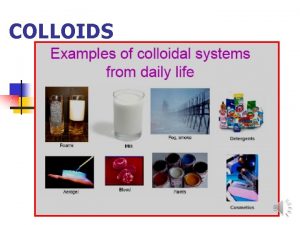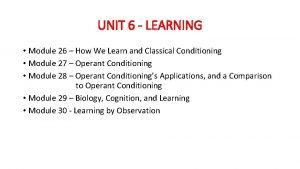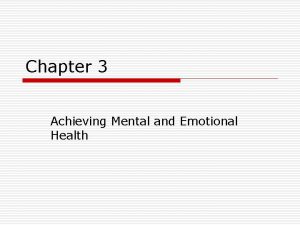What Youll Learn 1 Discuss physical and emotional






































































- Slides: 70

What You’ll Learn 1. Discuss physical and emotional changes during puberty. 2. Describe the functions of the female and male reproductive organs. 3. Identify concerns of reproductive health. 4. Identify ways to protect reproductive health. Click the mouse button or press the space bar to display information.

Key Terms • puberty • prostate gland • ovaries • Cowper’s glands • Fallopian tube • uterus • Pap smear • testosterone • epididymis • vas deferens Click the mouse button or press the space bar to display information.

Puberty in Females • Each stage of life is a process of change. • Puberty is the stage of growth and development when both the male and female body become capable of producing offspring. • During puberty, a female experiences physical and emotional changes. Click the mouse button or press the space bar to display information.

What to Know About Puberty in Females • When a female is around eight years old, the pituitary gland increases its production of a hormone called a follicle-stimulation hormone (FSH) which causes the ovaries to secrete estrogen. • Estrogen is a hormone produced by the ovaries that stimulates the development of female secondary sex characteristics and affects the menstrual cycle. • Secondary sex characteristics are physical and emotional changes that occur during puberty. Click the mouse button or press the space bar to display information.

What to Know About Puberty in Females • How to manage emotions – During puberty, estrogen and other hormones cause sudden emotional changes as hormone levels fluctuate. – Most changes in mood are normal. – The increase in estrogen also produces sexual feelings that result from a strong physical and emotional attraction to another person. – Females must set limits, stick to these limits, and practice abstinence. Click the mouse button or press the space bar to display information.

What to Know About Puberty in Females • How to accept physical changes – Physical changes that occur during puberty become noticeable between the ages of 8 and 15. – This maturing process is affected by heredity, diet, health habits, and health status. – During puberty, a female must become comfortable with her maturing body. – Body image is the perception a person has of his or her body’s appearance. Click the mouse button or press the space bar to display information.

What to Know About Puberty in Females Female Secondary Sex Characteristics Physical changes that occur during puberty: • increase in height • widening of the hips • softer and smoother skin • growth of pubic and underarm hair • increase in breast size Click the mouse button or press the space bar to display information. • enlargement of external genitalia • formation of mature ova • beginning of menstruation

The Female Reproductive System • The reproductive system is a major body system. • Reproduction is the mechanism that maintains life from one generation to another. • The female reproductive system consists of organs in the female body that are involved in producing offspring. Click the mouse button or press the space bar to display information.

What to Know About the Female Reproductive System • External female reproductive organs – The external female reproductive organs are called the vulva and consist of the mons veneris, the labia majora, the labia minora, the clitoris, and the hymen. – The mons veneris is the fatty tissue that covers the front of the pubic bone and serves as a protective cushion for the internal reproductive organs. Click the mouse button or press the space bar to display information.

What to Know About the Female Reproductive System • Internal female reproductive organs – The internal female reproductive organs are the ovaries, Fallopian tubes (also known as oviducts), uterus, and vagina. – The ovaries are female reproductive glands that produce ova and estrogen. Click the mouse button or press the space bar to display information.

What to Know About the Female Reproductive System • Internal female reproductive organs – A female is born with between 200, 000 and 400, 000 immature ova in her ovaries. – Each developing ovum is enclosed in a small, hollow ball called a follicle. – During a regular menstrual cycle, an ovum matures and is released from its follicle. – Ovulation is the release of a mature ovum from one of the two ovaries. Click the mouse button or press the space bar to display information.

What to Know About the Female Reproductive System • Internal female reproductive organs – When an ovum is released from an ovary, it enters one of the Fallopian tubes. – A Fallopian tube, or oviduct, is a tube through which an ovum moves from an ovary to the uterus. Click the mouse button or press the space bar to display information.

What to Know About the Female Reproductive System • Internal female reproductive organs – During the menstrual cycle, a mature ovum moves toward the uterus. – If fertilization occurs, it usually occurs in a Fallopian tube. Click the mouse button or press the space bar to display information.

What to Know About the Female Reproductive System • Internal female reproductive organs – The uterus is a muscular organ that receives and supports the fertilized ovum during pregnancy and contracts during childbirth to help with delivery. Click the mouse button or press the space bar to display information.

What to Know About the Female Reproductive System • Internal female reproductive organs – The cervix is the lowest part of the uterus that connects to the vagina. – The vagina is a muscular tube that connects the uterus to the outside of the body. Click the mouse button or press the space bar to display information.


Female Reproductive Health • During adolescence, females start to take more and more responsibility for their own health care. Click the mouse button or press the space bar to display information.

What to Know About Female Reproductive Health 1. What products can be used to absorb the menstrual flow? – Pads, panty shields or liners, and tampons are products that can be used to absorb the menstrual flow. 2. How can menstrual cramps be reduced? – A warm bath, moderate exercise, reducing the amount of caffeine and sodium in the diet, and some medications such as ibuprofen may relieve the cramps. Click the mouse button or press the space bar to display information.

What to Know About Female Reproductive Health 3. What is premenstrual syndrome (PMS)? – Premenstrual syndrome (PMS) is a combination of physical and emotional symptoms that affect a female a week to ten days prior to menstruation. – Regular exercise, a reduction in caffeine and salt in the diet, and some medications can help lessen the symptoms of PMS. Click the mouse button or press the space bar to display information.

What to Know About Female Reproductive Health 4. What causes a missed menstrual cycle? – Amenorrhea is the absence of menstruation. • The menstrual cycles of some females do not begin at puberty. This type of amenorrhea may be caused by underdeveloped female reproductive organs, poor general health, and/or emotional stress. • Some females miss additional menstrual cycles after their first menstrual cycle. This type of amenorrhea often is caused by pregnancy or a reduction in red blood cell levels. Click the mouse button or press the space bar to display information.

What to Know About Female Reproductive Health 5. What does a pelvic examination include? – A pelvic examination is an examination of the internal female reproductive organs that usually includes a Pap smear. – A Pap smear is a screening test in which cells are scraped from the cervix and examined to detect cervical cancer. Click the mouse button or press the space bar to display information.

What to Know About Female Reproductive Health 6. What is a yeast infection? – A yeast infection is a vaginal infection caused by a fungal organism. 7. What is toxic shock syndrome (TSS)? – Toxic shock syndrome (TSS) is a severe illness that results when vaginal bacteria secrete a toxin that gets into the bloodstream – Females can reduce the risk of TSS by changing pads tampons every four to six hours. Click the mouse button or press the space bar to display information.

What to Know About Female Reproductive Health 8. What is female infertility? – Infertility is a condition of the reproductive system that impairs the ability of a female to become pregnant. – The most common factors in female infertility are that an ovum may not be released each menstrual cycle, menstrual periods may be irregular, or Fallopian tubes may be blocked. Click the mouse button or press the space bar to display information.

What to Know About Female Reproductive Health 8. What is female infertility? – Some risks of infertility can be controlled, such as exposure to STDs, tobacco and marijuana use, intense exercise over a period of time, and excessive use of alcohol. – Other factors are poor general health, stress, eating disorders, drastic weight loss, and anemia. – Infertility is not the same as sterility, which is the inability to conceive under any circumstances. Click the mouse button or press the space bar to display information.

Protecting Female Reproductive Health • Protecting and maintaining the health of your reproductive system is important, not only at your present age, but also over your entire life span. • How well you protect your reproductive health now will influence your health as you grow older. Click the mouse button or press the space bar to display information.

How to Protect Female Reproductive Health • Practice abstinence from sex. Practicing abstinence prevents teen pregnancy and infection with sexually transmitted diseases. • Make a note of any questions you have about cramps, mood swings, or heavy menstrual flow. Share this information with your parents or guardian and your physician. Click the mouse button or press the space bar to display information.

How to Protect Female Reproductive Health • Practice good menstrual hygiene habits. Change your pad, panty shield, or tampon every four to six hours. • Choose habits that prevent or lessen menstrual cramps. Exercise regularly and reduce the amount of caffeine and salt in your diet. Click the mouse button or press the space bar to display information.

How to Protect Female Reproductive Health • Keep a calendar to record information about your menstrual cycle. Keep track of the number of days in each cycle, the number of days that you menstruate, and the date of your last menstrual period. • Perform monthly breast self-examinations. Perform a breast self-examination each month after your menstrual flow stops. Click the mouse button or press the space bar to display information.

How to Protect Female Reproductive Health • Have regular medical checkups. Your parents or guardian and your physician will determine the appropriate age for you to begin having a pelvic examination and a Pap smear. • Seek medical attention when you show signs of infection. Vaginal discharge, lumps, and rashes are symptoms of infection. Click the mouse button or press the space bar to display information.

How to Protect Female Reproductive Health • Breast cancer – Breast cancer is one of the most common types of cancer in women. – To help detect breast cancer early, women should do monthly breast examinations to check for lumps or changes. – With early detection and treatment, the chances of successfully treating breast cancer increase. Click the mouse button or press the space bar to display information.

The Menstrual Cycle • The menstrual cycle is the monthly series of changes that involves ovulation, changes in the uterine lining, and menstruation. • Menstruation is the period in the menstrual cycle in which the unfertilized egg and the lining of the uterus leave the body. Click the mouse button or press the space bar to display information.

What to Know About the Menstrual Cycle • Females often describe menstruation as their “period. ” • The menstrual cycle usually occurs over 28 days; however, many teens have irregular cycles and the length of their menstrual cycles varies. • Menstruation usually lasts about five days; however, the number of days also may vary. Click the mouse button or press the space bar to display information.

What to Know About the Menstrual Cycle • Days 1– 5 Menstruation occurs. At the same time, a new ovum is maturing in the ovary. • Days 6– 12 The uterine lining begins to thicken and the uterus prepares for ovulation and the possibility that an ovum will be fertilized. • Days 13– 14 Ovulation occurs. Click the mouse button or press the space bar to display information.

What to Know About the Menstrual Cycle • Days 15– 20 The corpus luteum secretes hormones to support a pregnancy. – The corpus luteum is a temporary gland that secretes progesterone. – Progesterone is a hormone that changes the lining of the uterus. – If an ovum is fertilized, the corpus luteum continues to secrete progesterone throughout pregnancy. Click the mouse button or press the space bar to display information.

What to Know About the Menstrual Cycle • Days 21– 28 The corpus luteum disintegrates if an ovum is not fertilized. The cells in the lining of the uterus die without progesterone. The unfertilized ovum disintegrates. The menstrual cycle begins again with menstruation. Click the mouse button or press the space bar to display information.

Puberty in Males • Puberty is the stage of growth and development when both the male and female bodies become capable of producing offspring. • It is a time of great physical and emotional changes. Click the mouse button or press the space bar to display information.

What to Know About Puberty in Males • During puberty, the male’s pituitary gland increases its production of a hormone called luteinizing hormone (LH), which causes the testes to secrete testosterone. • Testosterone is a hormone that produces the male secondary sex characteristics. • Secondary sex characteristics are the emotional and the physical changes that occur during puberty. Click the mouse button or press the space bar to display information.

What to Know About Puberty in Males • How to manage emotions – During puberty, fluctuating testosterone levels cause sudden emotional changes in males. – Changes in emotions are normal during puberty. – Because increased testosterone also produces sexual feelings, males must learn to set limits, stick to these limits, and practice abstinence. Click the mouse button or press the space bar to display information.

What to Know About Puberty in Males • How to accept physical changes – Physical changes that occur in a male during puberty become noticeable between the ages of 12 and 15. – The maturing process that happens in puberty is affected by several factors, including heredity, diet, health habits, and health status. Click the mouse button or press the space bar to display information.

What to Know About Puberty in Males Male Secondary Sex Characteristics The following are some physical changes that occur during puberty: • increase in height • • • growth of facial hair, pubic hair, and body hair longer and heavier bones • enlargement of penis, broader shoulders scrotum, and testes thicker and tougher skin • formation of sperm deepened voice Click the mouse button or press the space bar to display information.

The Male Reproductive System • The male reproductive system consists of organs in the male body that are involved in producing offspring. • The physical changes that produce sexual maturity are caused by the increased production of male hormones. Click the mouse button or press the space bar to display information.

The Male Reproductive System Click the mouse button or press the space bar to display information.

What to Know About the Male Reproductive System • External male reproductive organs – The external organs of the male reproductive system are the penis and the scrotum. – The penis is the male sex organ used for reproduction and urination. – The scrotum is a saclike pouch that hangs under the penis and holds the testes. Click the mouse button or press the space bar to display information.

What to Know About the Male Reproductive System • External male reproductive organs – The testes are male reproductive glands that produce sperm cells and the hormone testosterone. – Sperm are male reproductive cells. – A sperm is made up of a head, which contains the nucleus of the cell, a body, and a tail. Click the mouse button or press the space bar to display information.

What to Know About the Male Reproductive System • Internal male reproductive organs – The internal male reproductive organs include the testes, seminiferous tubules, epididymis, vas deferens, seminal vesicles, ejaculatory duct, prostate gland, Cowper’s glands, and urethra. Click the mouse button or press the space bar to display information.

What to Know About the Male Reproductive System • Internal male reproductive organs – The testes are divided into several sections that are filled with seminiferous tubules, a network of coiled tubules in which sperm are produced. – Spermatogenesis is the process by which sperm are produced. – Sperm development is a result of a hormone produced by the pituitary gland. Click the mouse button or press the space bar to display information.

What to Know About the Male Reproductive System • Internal male reproductive organs – After sperm are produced in the seminiferous tubules, they move by contractions from the testes to the epididymis. – The epididymis is a comma-shaped structure along the upper rear surface of the testes where sperm mature. – Most sperm move from the epididymis to the vas deferens after they mature. Click the mouse button or press the space bar to display information.

What to Know About the Male Reproductive System • Internal male reproductive organs – The vas deferens are two long, thin tubes that act as a passageway for sperm and a place for sperm storage. – The vas deferens connect with the ducts of the seminal vesicles to form the ejaculatory duct. Click the mouse button or press the space bar to display information.

What to Know About the Male Reproductive System • Internal male reproductive organs – The seminal vesicles are two saclike glands at the base of the bladder that secrete a fluid that nourishes sperm and helps them move. – The ejaculatory duct is a short, straight tube that passes into the prostate gland opens into the urethra. – The urethra serves as a passageway for sperm and urine to leave the body. Click the mouse button or press the space bar to display information.

What to Know About the Male Reproductive System • Internal male reproductive organs – The prostate gland is a gland that produces a fluid that helps keep sperm alive. – Cowper’s glands are two small glands located beneath the prostate gland, that secrete a clear, lubricating fluid into the urethra. – Semen is the fluid that is released by the reproductive tract. It contains sperm and fluids from the seminal testicles, prostate gland, and Cowper’s glands. Click the mouse button or press the space bar to display information.

What to Know About the Male Reproductive System • Internal male reproductive organs – An erection is a process that occurs when the penis swells with blood and elongates. – Ejaculation is the passage of semen from the penis and is a result of a series of involuntary muscular contractions. – After ejaculation, the penis returns to a nonerect state. Click the mouse button or press the space bar to display information.


Male Reproductive Health • There are many physical changes that an adolescent male experiences that are a normal part of maturing. Click the mouse button or press the space bar to display information.

What to Know About Male Reproductive Health 2. What causes an inguinal hernia? – In a developing fetus, the testes pass from the abdomen into the scrotum through the inguinal canal, which then closes. – In some males, the inguinal canal does not completely close off. – The result is an inguinal hernia, which is a hernia in which some of the intestine pushes through the inguinal canal into the scrotum. Click the mouse button or press the space bar to display information.

What to Know About Male Reproductive Health 3. How can having mumps after puberty cause sterility? – Mumps is a viral infection that affects the salivary glands. – If a male has mumps after puberty, the virus can cause swelling of the testes and possibly crush the seminiferous tubules. – This causes sterility, which is the inability to produce offspring. Click the mouse button or press the space bar to display information.

What to Know About Male Reproductive Health 4. Why should males have a digital rectal examination? – Physicians use digital rectal examinations to examine males for symptoms of prostate cancer. – A digital rectal examination is an examination in which the physician inserts a finger into the rectum and examines the internal reproductive organs and the rectum for irregularities. Click the mouse button or press the space bar to display information.

What to Know About Male Reproductive Health 5. What is a testicular self-examination? – The best way to detect testicular cancer is by doing regular testicular self-examinations. – A testicular self-examination is a screening procedure for testicular cancer in which a male checks his testes for lumps or tenderness. – If detected early, testicular cancer has a high rate of cure. Click the mouse button or press the space bar to display information.

What to Know About Male Reproductive Health 6. What is male infertility? – The prime cause of male infertility concerns his sperm, which can be affected by mumps, sexually transmitted diseases, injuries, or hormone disorders. – Some risks of infertility can be controlled, including exposure to STDs, tobacco and marijuana use, intense exercise over a period of time, and excessive use of alcohol. Click the mouse button or press the space bar to display information.

Protecting Male Reproductive Health • The care given to one body system affects the entire body. • Protecting the reproductive system will help maintain and promote overall health now and in the future. • Having regular checkups is an important part of protecting health. Click the mouse button or press the space bar to display information.

How to Protect Male Reproductive Health • Practice abstinence from sex. Practicing abstinence prevents teen pregnancy and infection with sexually transmitted diseases, including HIV. • Bend at the knees and keep your back straight when lifting heavy objects. Use the correct technique when lifting heavy objects to help prevent the risk of an inguinal hernia. Click the mouse button or press the space bar to display information.

How to Protect Male Reproductive Health • Wear protective clothing and equipment when participating in sports and physical activities. You should wear protective equipment, such as a cup, to prevent injury to the penis and scrotum. • Perform testicular self-examinations. Testicular cancer is one of the most common cancers in younger males. Click the mouse button or press the space bar to display information.

How to Protect Male Reproductive Health • Have regular medical checkups. Your physician will perform an examination and discuss the ways your body is changing. • Seek medical attention when you show signs of infection. A discharge from the penis, tenderness in the scrotum, lumps, and rashes are symptoms of STDs. Click the mouse button or press the space bar to display information.

How to Protect Male Reproductive Health • Bathe or shower daily. Keep your external reproductive organs clean to prevent infection and odor. • Maintain a positive body image. During puberty, a male must become comfortable with his maturing body. The growth spurt in males occurs later than it does in females, and males mature at different rates. Click the mouse button or press the space bar to display information.

1 B, 1 I, 2 A, 6 B, 12 A Study Guide 1. Match the following terms and definitions. ___ C estrogen ___ E Pap smear ___ A testosterone ___ D ovaries ___ B spermatogenesis A. a hormone that produces the male secondary sex characteristics B. the process by which sperm are produced C. a hormone produced by the ovaries that stimulates development of female secondary sex characteristics D. female reproductive glands that produce ova and estrogen E. a screening test in which cells are scraped from the cervix and examined to detect cervical cancer Click the mouse button or press the space bar to display information.

Study Guide 1 B, 1 I, 2 A, 6 B, 12 A, 17 B 2. Identify the following statements as true or false. _______ Amenorrhea can be caused by drastic true weight loss. _______ false The Cowper’s glands are located above the prostate gland. _______ false FSH causes the testes to secrete testosterone. _______ The corpus luteum secretes progesterone. true _______ With early detection, testicular cancer has a true high rate of cure. Click the mouse button or press the space bar to display information.

Study Guide 1 B, 12 A, 17 B 3. What is the difference between infertility and sterility? Infertility is a temporary condition in which the ability to produce offspring is impaired. Sterility is a permanent inability to produce offspring. Click the mouse button or press the space bar to display information.


Lesson Resources tx. healthmh. com/puberty tx. healthmh. com/reproductive_systems tx. healthmh. com/reproductive_health tx. healthmh. com/study_guide

To navigate within this Interactive Chalkboard product: Click the Forward button to go to the next slide. Click the Previous button to return to the previous slide. Click the Lesson Resources button to go to the Lesson Resources slide where you can access resources, such as transparencies, that are available for the lesson. Click the Menu button to close the lesson presentation and return to the Main Menu. If you opened the lesson presentation directly without using the Main Menu, this will exit the presentation. You also may press the Escape key [Esc] to exit and return to the Main Menu. Click the Help button to access this screen. Click the Health Online Button to access the Web page associated with the particular lesson you are working with. Click the Speaker button to hear the vocabulary term and definition when available.

This slide is intentionally blank.
 Amateurs discuss tactics professionals discuss logistics
Amateurs discuss tactics professionals discuss logistics Tactile learner definition
Tactile learner definition Discuss about physical incompatibility with examples
Discuss about physical incompatibility with examples Physical incompatibility examples
Physical incompatibility examples Physical emotional mental spiritual
Physical emotional mental spiritual Non physical fences example
Non physical fences example Physical fitness components and tests grade 9
Physical fitness components and tests grade 9 Comparison between guidance and counselling
Comparison between guidance and counselling Abstract decorative design
Abstract decorative design Discuss the nature and concept of collaborative justice
Discuss the nature and concept of collaborative justice The meaning of educational psychology
The meaning of educational psychology Look at the pictures and say the answers
Look at the pictures and say the answers Discuss about information technology and e-business
Discuss about information technology and e-business Discuss in detail the concept and process of hydrosere'
Discuss in detail the concept and process of hydrosere' Definition paragraphs
Definition paragraphs Future trends in media and information
Future trends in media and information Review and discuss
Review and discuss Listen and discuss
Listen and discuss Activity 2 in pairs discuss the following questions
Activity 2 in pairs discuss the following questions Omar is going to the watani football school
Omar is going to the watani football school Nature and scope of macro economics
Nature and scope of macro economics Work in pairs discuss these questions
Work in pairs discuss these questions Exploratory vs descriptive vs causal research
Exploratory vs descriptive vs causal research Origin of pharmacognosy
Origin of pharmacognosy Expand by giving an example
Expand by giving an example Protective colloid
Protective colloid Work in pairs look at the pictures
Work in pairs look at the pictures Work in pairs and answer the questions.
Work in pairs and answer the questions. Work in pairs.answer the questions
Work in pairs.answer the questions With whom did shilpi and her husband discuss pregnancy?
With whom did shilpi and her husband discuss pregnancy? Evolution of leisure and recreation
Evolution of leisure and recreation Look at the photo and answer the questions
Look at the photo and answer the questions Client server architectures
Client server architectures Think pair share definition
Think pair share definition Principles of new criticism
Principles of new criticism Characteristics of formal communication
Characteristics of formal communication Discuss and decide
Discuss and decide Work in pairs. look at the photo and answer the questions
Work in pairs. look at the photo and answer the questions Dimitri and linda are trying to learn a new routine
Dimitri and linda are trying to learn a new routine Learn and share in english 3
Learn and share in english 3 Prqrt
Prqrt Art and science of helping adults learn
Art and science of helping adults learn Module 26 ap psychology
Module 26 ap psychology Innateness theory
Innateness theory Learning pivot tables and vlookups
Learning pivot tables and vlookups Lunch and learn survey questions
Lunch and learn survey questions 0° latitude
0° latitude Learn and share in english 2
Learn and share in english 2 Berlin and fowkes learn model
Berlin and fowkes learn model Do children learn through structured input
Do children learn through structured input Learn quran and salah the easy way
Learn quran and salah the easy way You live to learn
You live to learn How to learn longitude and latitude
How to learn longitude and latitude Learn sheffield training and development hub
Learn sheffield training and development hub Read the headlines below and match them to the pictures
Read the headlines below and match them to the pictures How do boys and girls learn differently
How do boys and girls learn differently Chapter 3 lesson 3 expressing emotions in healthful ways
Chapter 3 lesson 3 expressing emotions in healthful ways Assistive technology for emotional and behavioral disorders
Assistive technology for emotional and behavioral disorders Sears assessment
Sears assessment Fictional character names
Fictional character names Unpleasant sensory and emotional experience
Unpleasant sensory and emotional experience Slidetodoc.com
Slidetodoc.com Chapter 5 lesson 4 getting help answer key
Chapter 5 lesson 4 getting help answer key Emotional health and wellbeing framework
Emotional health and wellbeing framework Social development in middle childhood
Social development in middle childhood Social development in middle adulthood
Social development in middle adulthood Chapter 5 mental and emotional problems answer key
Chapter 5 mental and emotional problems answer key Mental vs emotional
Mental vs emotional Chapter 3 achieving mental and emotional health
Chapter 3 achieving mental and emotional health Emotional growth
Emotional growth Madcud
Madcud






























































































